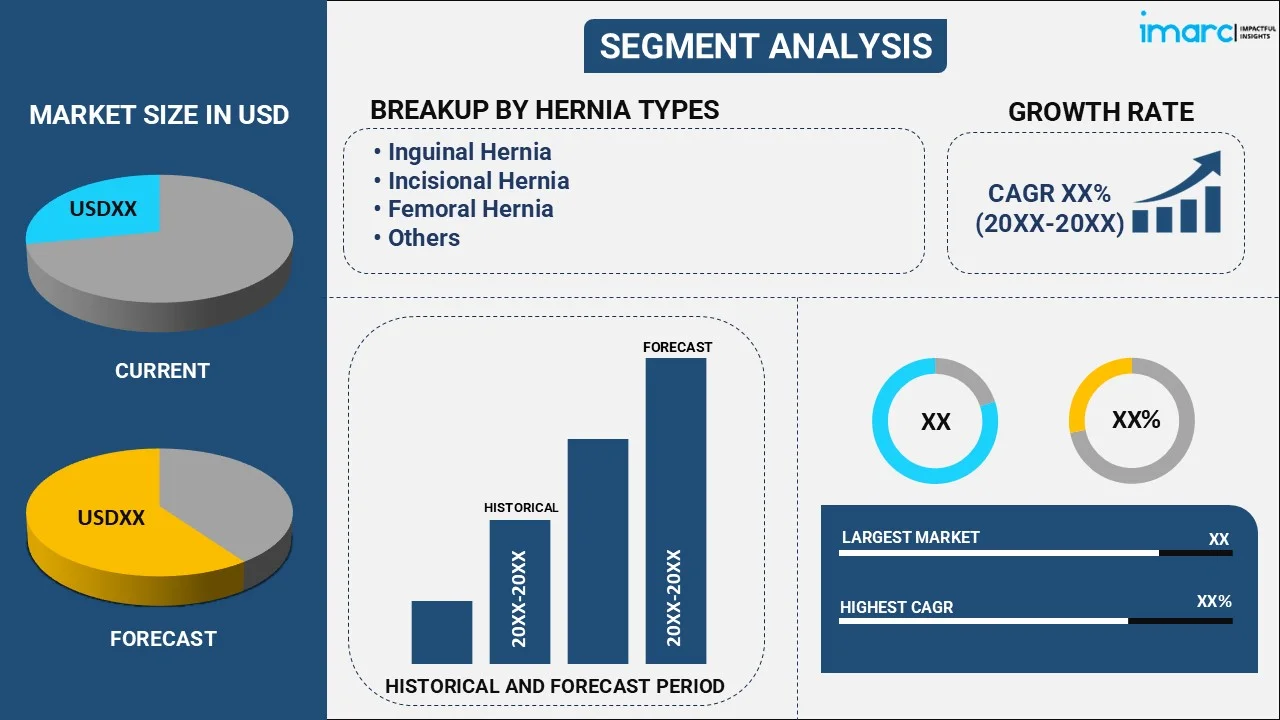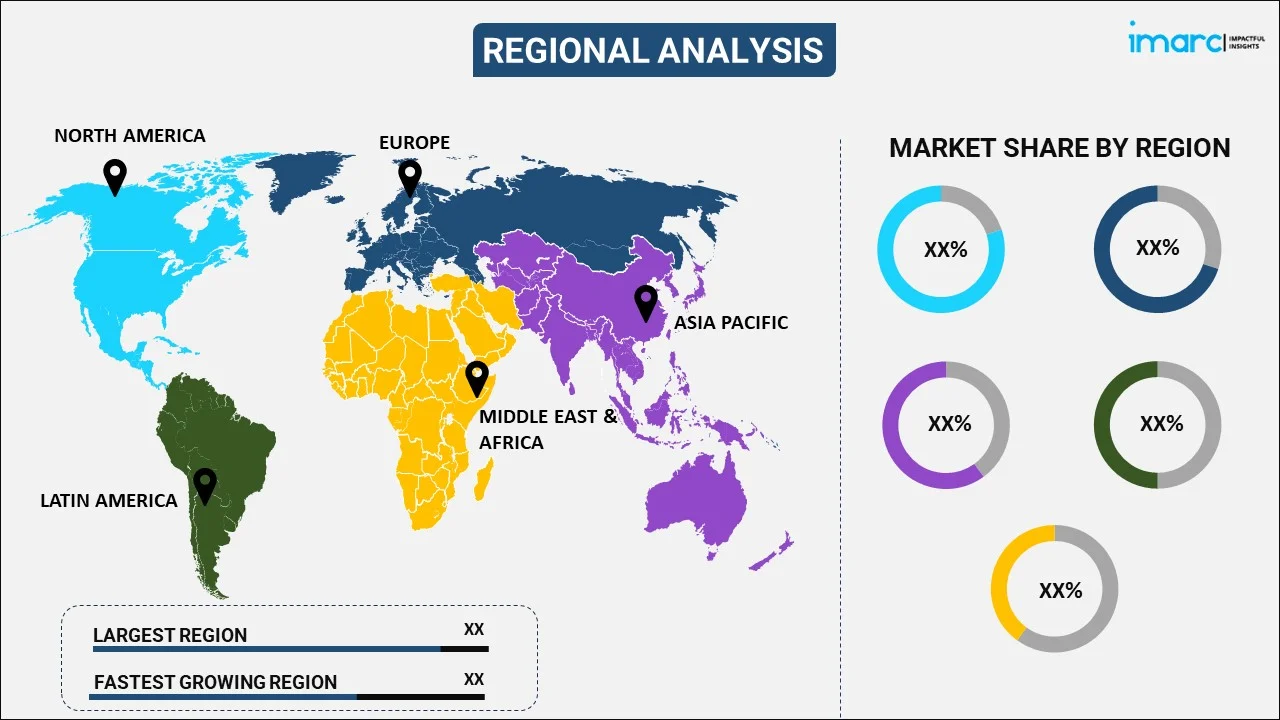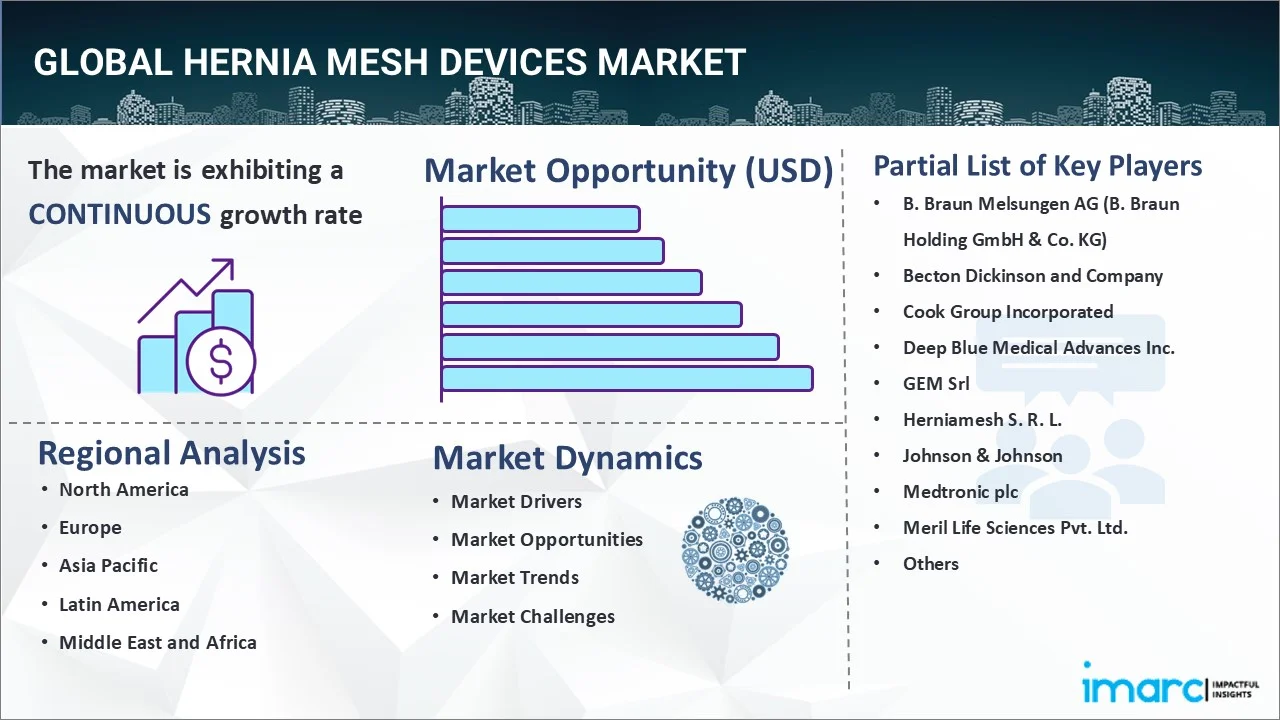
Hernia Mesh Devices Market Report by Hernia Type (Inguinal Hernia, Incisional Hernia, Femoral Hernia, and Others), Mesh (Biologic Mesh, Synthetic Mesh), End User (Hospitals, Clinics, Ambulatory Surgical Centers, and Others), and Region 2025-2033
Global Hernia Mesh Devices Market:
The global hernia mesh devices market size reached USD 2.06 Billion in 2024. Looking forward, IMARC Group expects the market to reach USD 2.63 Billion by 2033, exhibiting a growth rate (CAGR) of 2.76% during 2025-2033. The increasing number of hospitals, clinics, and ambulatory surgical centers is stimulating the market.
|
Report Attribute
|
Key Statistics
|
|---|---|
|
Base Year
|
2024
|
|
Forecast Years
|
2025-2033
|
|
Historical Years
|
2019-2024
|
|
Market Size in 2024
|
USD 2.06 Billion |
|
Market Forecast in 2033
|
USD 2.63 Billion |
| Market Growth Rate 2025-2033 | 2.76% |
Hernia Mesh Devices Market Analysis:
- Major Market Drivers: The rising occurrence of hernia, on account of diarrhea or constipation, obesity, persistent coughing, poor nutrition, smoking, and overexertion, is stimulating the market.
- Key Market Trends: The introduction of articulating fixation devices that offer surgeons better access to weak spots within the abdominal wall and enable them to place the mesh at the desired body site securely is acting as a significant growth-inducing factor.
- Competitive Landscape: Some of the prominent companies in the market include B. Braun Melsungen AG (B. Braun Holding GmbH & Co. KG), Becton Dickinson and Company, Cook Group Incorporated, Deep Blue Medical Advances Inc., GEM Srl, Herniamesh S. R. L., Johnson & Johnson, Medtronic plc, Meril Life Sciences Pvt. Ltd., Novus Scientific AB, Samyang Holding Corporation, Stryker Corporation, and W. L. Gore & Associates Inc, among many others.
- Geographical Trends: The increasing demand for robotic hernia surgeries is propelling the market in North America.
- Challenges and Opportunities: One of the challenges hindering the market is the risk of complications. However, the growing focus on advancing biocompatible materials is expected to fuel the market in the coming years.
Hernia Mesh Devices Market Trends:
Rising Preference for Laparoscopic Procedures
Laparoscopic hernia repair usually involves the use of a camera and small incisions to guide the placement of the mesh. This, in turn, results in quicker recovery times, less postoperative pain, and reduced hospital stays compared to traditional open surgery. In April 2024, one of the medical technology companies, TELA Bio, announced the commercial launch of OviTex inguinal hernia repair (IHR) reinforced tissue matrix, a product tailored for laparoscopic and robotic-assisted procedures, in the U.S. It offers flexibility for surgeons based on patient needs and procedural preferences.
Expanding Adoption of Robotic-Assisted Surgery
The inflating need for improving the accuracy of mesh placement, more complex maneuvers, and minimizing the risk of complications is catalyzing the market. Robotic-assisted surgery also offers benefits, such as reduced blood loss, smaller incisions, and quicker recovery times, for patients. In May 2024, Medtronic initiated additional clinical studies of its Hugo robotic-assisted surgery system to expand its indications to hernia and gynecology. This is bolstering the hernia mesh devices market outlook report.
Increasing Focus on Patient-Specific Solutions
Numerous advancements in imaging technologies and computer modeling, which enable precise preoperative planning and customized mesh designs, are catalyzing the market. Patient-specific solutions aim to minimize complications, enhance the success rates of hernia repairs, and improve overall patient satisfaction. In January 2024, Absolutions received an FDA breakthrough designation for an abdominal wall closure device to reduce the risk of hernia by distributing suture tension over a large area of tissue.
Global Hernia Mesh Devices Industry Segmentation:
IMARC Group provides an analysis of the key trends in each segment of the market, along with the hernia mesh devices market forecast at the global, regional, and country levels for 2025-2033. Our report has categorized the market based on the hernia type, mesh, and end user.
Breakup by Hernia Type:

- Inguinal Hernia
- Incisional Hernia
- Femoral Hernia
- Others
Inguinal hernia dominates the hernia mesh devices market outlook
The report has provided a detailed breakup and analysis of the market based on the hernia type. This includes inguinal hernia, incisional hernia, femoral hernia, and others. According to the report, inguinal hernia represented the largest market segmentation.
An inguinal hernia occurs when a portion of the intestine protrudes through a weakened spot in the abdominal muscles. Addressing this common condition, several companies have recently launched innovative products. For example, Medtronic introduced the Parietex Hybrid Mesh, which combines non-absorbable and absorbable components to enhance biocompatibility and tissue integration.
Breakup by Mesh:
- Biologic Mesh
- Synthetic Mesh
Synthetic mesh currently holds most of the total hernia mesh devices market share
The report has provided a detailed breakup and analysis of the market based on the mesh. This includes biologic mesh and synthetic mesh. According to the report, synthetic mesh represented the largest market segmentation.
Synthetic mesh devices represent medical implants made from materials like polypropylene, designed to provide support to weakened or damaged tissue. Bard unveiled the Ventralight ST Mesh, featuring a lightweight, large-pore design with a bioresorbable coating that promotes better tissue integration.
Breakup by End User:
- Hospitals
- Clinics
- Ambulatory Surgical Centers
- Others
Hospitals hold the majority of the global hernia mesh devices market demand
The report has provided a detailed breakup and analysis of the market based on the end user. This includes hospitals, clinics, ambulatory surgical centers, and others. According to the report, hospitals represented the largest market segmentation.
Hernia mesh devices are medical implants used in hospitals to repair hernias by providing additional support to weakened or damaged tissue. Becton, Dickinson, and Company developed an optilene mesh that is engineered to reduce the risk of adhesion and infection while providing robust support for tissue regeneration.
Breakup by Region:

- North America
- United States
- Canada
- Asia-Pacific
- China
- Japan
- India
- South Korea
- Australia
- Indonesia
- Others
- Europe
- Germany
- France
- United Kingdom
- Italy
- Spain
- Russia
- Others
- Latin America
- Brazil
- Mexico
- Others
- Middle East and Africa
North America exhibits a clear dominance in the market
The hernia mesh devices market research report has also provided a comprehensive analysis of all the major regional markets, which include North America (the United States and Canada); Asia Pacific (China, Japan, India, South Korea, Australia, Indonesia, and others); Europe (Germany, France, the United Kingdom, Italy, Spain, Russia, and others); Latin America (Brazil, Mexico, and others); and the Middle East and Africa. According to the report, North America accounted for the largest market share.
As per the hernia mesh devices market analysis report, North America exhibits a clear dominance in the market, driven by advancements in surgical techniques, growing incidences of hernias, and a strong focus on improving patient outcomes. In January 2024, TELA Bio Inc., a commercial-stage medical technology company, introduced LIQUIFIX precision and LIQUIFIX FIX8 laparoscopic open hernia mesh fixation devices in the U.S. Both devices are the only FDA-approved devices that affix mesh and approximate peritoneal tissue with liquid anchors.
Competitive Landscape:
The market research report has provided a comprehensive analysis of the competitive landscape. Detailed profiles of all major market companies have also been provided. Some of the key players in the market include:
- B. Braun Melsungen AG (B. Braun Holding GmbH & Co. KG)
- Becton Dickinson and Company
- Cook Group Incorporated
- Deep Blue Medical Advances Inc.
- GEM Srl
- Herniamesh S. R. L.
- Johnson & Johnson
- Medtronic plc
- Meril Life Sciences Pvt. Ltd.
- Novus Scientific AB
- Samyang Holding Corporation
- Stryker Corporation
- W. L. Gore & Associates Inc
(Please note that this is only a partial list of the key players, and the complete list is provided in the report.)
Hernia Mesh Devices Market Recent Developments:
- May 2024: Medtronic initiated additional clinical studies of its Hugo robotic-assisted surgery system to expand its indications to hernia and gynecology.
- April 2024: One of the medical technology companies, TELA Bio, announced the commercial launch of hernia mesh devices tailored for laparoscopic and robotic-assisted procedures in the U.S.
- January 2024: Absolutions received an FDA breakthrough designation for an abdominal wall closure device to reduce the risk of hernia by distributing suture tension over a large area of tissue.
Hernia Mesh Devices Market Report Scope:
| Report Features | Details |
|---|---|
| Base Year of the Analysis | 2024 |
| Historical Period | 2019-2024 |
| Forecast Period | 2025-2033 |
| Units | Billion USD |
| Scope of the Report | Exploration of Historical Trends and Market Outlook, Industry Catalysts and Challenges, Segment-Wise Historical and Predictive Market Assessment:
|
| Hernia Types Covered | Inguinal Hernia, Incisional Hernia, Femoral Hernia, Others |
| Meshs Covered | Biologic Mesh, Synthetic Mesh |
| End Users Covered | Hospitals, Clinics, Ambulatory Surgical Centers, Others |
| Regions Covered | Asia Pacific, Europe, North America, Latin America, Middle East and Africa |
| Countries Covered | United States, Canada, Germany, France, United Kingdom, Italy, Spain, Russia, China, Japan, India, South Korea, Australia, Indonesia, Brazil, Mexico |
| Companies Covered | B. Braun Melsungen AG (B. Braun Holding GmbH & Co. KG), Becton Dickinson and Company, Cook Group Incorporated, Deep Blue Medical Advances Inc., GEM Srl, Herniamesh S. R. L., Johnson & Johnson, Medtronic plc, Meril Life Sciences Pvt. Ltd., Novus Scientific AB, Samyang Holding Corporation, Stryker Corporation, W. L. Gore & Associates Inc., etc. |
| Customization Scope | 10% Free Customization |
| Post-Sale Analyst Support | 10-12 Weeks |
| Delivery Format | PDF and Excel through Email (We can also provide the editable version of the report in PPT/Word format on special request) |
Key Benefits for Stakeholders:
- IMARC's industry report offers a comprehensive quantitative analysis of various market segments, historical and current market trends, market forecasts, and dynamics of the hernia mesh devices market from 2019-2033.
- The research report provides the latest information on the market drivers, challenges, and opportunities in the global hernia mesh devices market.
- The study maps the leading, as well as the fastest-growing, regional markets. It further enables stakeholders to identify the key country-level markets within each region.
- Porter's five forces analysis assists stakeholders in assessing the impact of new entrants, competitive rivalry, supplier power, buyer power, and the threat of substitution. It helps stakeholders to analyze the level of competition within the hernia mesh devices industry and its attractiveness.
- The competitive landscape allows stakeholders to understand their competitive environment and provides insight into the current positions of key players in the market.
Key Questions Answered in This Report
The global hernia mesh devices market was valued at USD 2.06 Billion in 2024.
We expect the global hernia mesh devices market to exhibit a CAGR of 2.76% during 2025-2033.
The rising adoption of hernia mesh devices in hospitals, clinics, and ambulatory surgical centers, as they enhance patient outcomes by minimizing operative time, is primarily driving the global hernia mesh devices market growth.
The sudden outbreak of the COVID-19 pandemic had led to the postponement of elective hernia treatment procedures to reduce the risk of the coronavirus infection upon hospital visits and interaction with medical equipment, thereby negatively impacting the global market for hernia mesh devices.
Based on the hernia type, the global hernia mesh devices market can be categorized into inguinal hernia, incisional hernia, femoral hernia, and others. Among these, inguinal hernia accounts for the majority of the global market share.
Based on the mesh, the global hernia mesh devices market has been segregated into biologic mesh and synthetic mesh, where synthetic mesh currently exhibits a clear dominance in the market.
Based on the end user, the global hernia mesh devices market can be bifurcated into hospitals, clinics, ambulatory surgical centers, and others. Currently, hospitals hold the largest market share.
On a regional level, the market has been classified into North America, Asia-Pacific, Europe, Latin America, and Middle East and Africa, where North America currently dominates the global market.
Some of the major players in the global hernia mesh devices market include B. Braun Melsungen AG (B. Braun Holding GmbH & Co. KG), Becton Dickinson and Company, Cook Group Incorporated, Deep Blue Medical Advances Inc., GEM Srl, Herniamesh S. R. L., Johnson & Johnson, Medtronic plc, Meril Life Sciences Pvt. Ltd., Novus Scientific AB, Samyang Holding Corporation, Stryker Corporation, and W. L. Gore & Associates Inc.
Need more help?
- Speak to our experienced analysts for insights on the current market scenarios.
- Include additional segments and countries to customize the report as per your requirement.
- Gain an unparalleled competitive advantage in your domain by understanding how to utilize the report and positively impacting your operations and revenue.
- For further assistance, please connect with our analysts.

 Inquire Before Buying
Inquire Before Buying
 Speak to an Analyst
Speak to an Analyst
 Request Brochure
Request Brochure
 Request Customization
Request Customization




.webp)




.webp)












